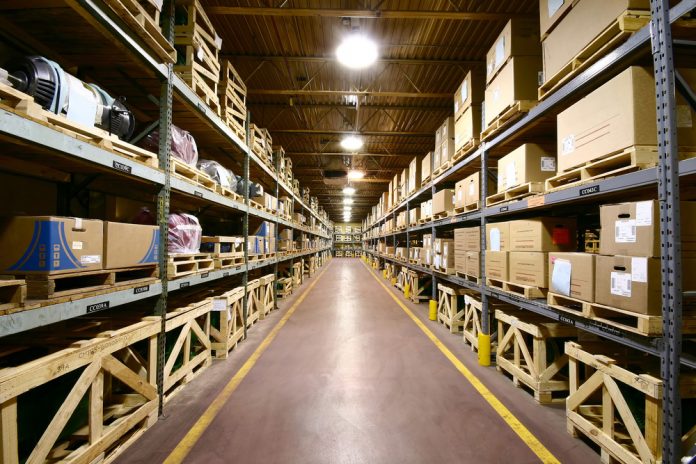Technology is advancing, revolutionizing the entire landscape of commerce and changing traditional business processes… forever.
Machines and automated systems are now available to improve business efficiency and produce maximum output. When it comes to the manufacturing industry, it is almost impossible to develop and scale a business without the use of automated material handling.
What Is an Automated Material Handling System?
Automated material handling is an ‘automated’ system of machines that can help to check in and check out items, sort materials, move bins around, stack bins, etc.
What these systems do is ensure the proper transport of materials in a manufacturing environment.
These systems are highly advanced and can scan barcodes. They can identify the location of materials and even transport materials to separate buildings on a property.
These automated material handling systems are intended to help manufacturers meet or exceed performance goals.
The technology is becoming so advanced that these systems can ‘work’ faster than that of humans, allowing manufacturers to streamline the manufacturing process and get more done in a shorter amount of time.
In this dynamic industry, change is inevitable and you need to know who to trust when integrating materials handling systems.
What Are Its Main Functions?
These automated systems utilize tracking to process and transport materials. These systems can be partially-implemented, meaning they require the help of human employees, or they can be completely implemented, running on their own.
An example of the main functions of these systems include:
- moving products
- pulling and storing pallets
- de-stacking and stacking pallets
- order filling stations
- overhead cranes
- pick and drop systems
- electrical material carts
- finding lost materials or packages
These systems have a wide array of functions designed to help streamline and automate the manufacturing process.
What Are the Applications of Automated Material Handling for Manufactures?
Automated material handling systems can work (and are currently being used) in many different industries, such as:
- automobiles
- healthcare
- construction/building
- third party logistics
These systems have a versatile range of functions that can help many businesses lower costs, optimize their process, and increase output.
Benefits of an Automated Material Handling System
There are many benefits of automated material handling systems.
Some of the main benefits include:
- Saving money (by reducing the need for employees and getting the work done faster, manufacturers can significantly reduce costs by using an automated material handling system).
- Eliminating accidents (without employees, accidents rarely ever happen — when it comes to manufacturing, employee safety is a top priority. By eliminating accidents, businesses are saving themselves from a lot of problems).
- Maximizing space (with automated systems, more of the warehouse space can be used. Items can be stacked higher and can be reached easier since the material handling automation is capable of far more than a human employee).
- Faster service (when automated material handling systems are implemented for manufacturers, everything is done faster — this means items get shipped to customers sooner, increasing customer satisfaction dramatically).
- Increased warehouse value (when these automated systems are included in a warehouse purchase, this attracts more buyers and also increases the price of the warehouse significantly).
- Employee benefits (higher-value employees are drawn to warehouses with automated systems — it attracts high-quality workers who have more specific training).
- Optimize efficiency (automated material handling systems optimize the entire manufacturing process).
Let’s take a closer look at how these automated systems optimize the manufacturing process.
How Can Automated Material Handling Optimize Manufacturing Processes?
Manufacturing is a historically time-sensitive operation, no matter the size or scale of the business.
Meeting deadlines and output goals naturally leads to stress, issues, and mistakes. When these problems occur, this can derail the entire process and could mean lots of lost revenue for the business.
Some of the main challenges that plague manufacturing today include:
- Worker issues (finding skilled workers in the first place is hard enough — but, it is also difficult to ensure all team members are working at full efficiency and avoiding all easy-to-avoid mistakes).
- Inventory management (managing inventory is a big job that is bound to result in problems — having a system is key to staying on top of inventory management).
- Project management (managing various projects is also hard, which is why a system is so important).
- Competing with eCommerce (now that buying online is more commonplace than ever, efficiency in the manufacturing process is crucial — a centralized and easy-to-manage automated manufacturing system helps ensure maximum efficiency).
- Scaling and growth (scaling operations to coincide with a growing business can be impossible without the help of machines and an automated system. Also, the more a business grows, the more issues — this is also why an automated system is necessary).
Implementing automated material handling systems better equips manufacturers to deal with business challenges and help optimize efficiency.
With human workers and traditional processes, challenges occur. These problems are tricky to solve and, especially when scaling, non-machine systems are hard to manage.
By using automated material handling, manufacturing is easier and more efficient than it ever has been before.
Why Automated Material Handling Systems Are Essential
Automated material handling systems are necessary for business development in the manufacturing industry today. These systems help reduce employee issues, avoid injury, increase efficiency, and save money.
Today, consumers expect their packages to arrive almost immediately. The bar is high for producers, so the manufacturing process needs to be as efficient as possible in order to compete.
In times of fierce competition between manufacturers, automated material handling produces tangible results that allow businesses the competitive upside they need to stay ahead.
Find a Home-Based Business to Start-Up >>> Hundreds of Business Listings.

















































